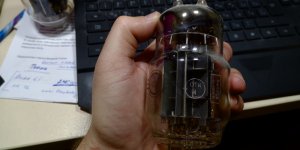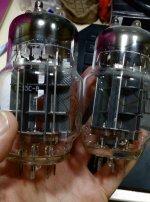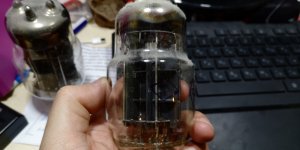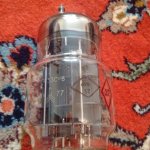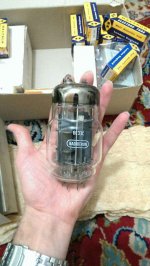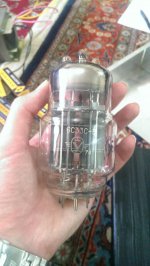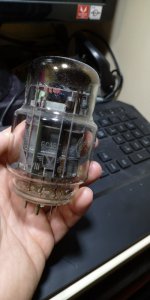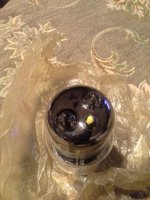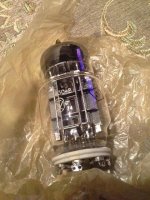imho otk means nothing. i have tubes with otk no.1. otk means-quality control department abbreviation and department.no.
i've read that the otk number related to the year of producing the tube
and
year by year the quality and cathode current is different with each other
production date should be printed on tube..but can wear off due time ..my tube with date 12month 86year has otk 1. but otk 4 has 88/11 year month stamp.
As others wrote OTK only means that the tube has passed military quality control, note! the OTK mark is printed with purple ink that gets black when the tubes has been warmed up so if the OTK mark is black the tube has been used.
date is always marked with etching of year and month like 9006, or sometimes with roman letters for month and numeric for year like IV88
The difference between different 6C33C is parameter tolerance, I believe that they maybe sampled tubes due to parameters and marked them differently.
6C33C without any more letters has widest tolerances and 6C33C-B has most narrow tolerances, 6C33C-BP is in between but has longest life expectancy according to the datasheet, 6C33C-B also have highest specs for vibration and shock. When used in audio amplifiers I have not seen any differences between these different versions.
Note, the life expectancy figures in the datasheets is when all parameters are fulfilled, i.e the tube operating at full anode dissipation and full current and still meeting specs for vibration and shock, therefore the life expectancy figure are low, between 750 - 3000 hours but used more carefully this tube has very long life.
date is always marked with etching of year and month like 9006, or sometimes with roman letters for month and numeric for year like IV88
The difference between different 6C33C is parameter tolerance, I believe that they maybe sampled tubes due to parameters and marked them differently.
6C33C without any more letters has widest tolerances and 6C33C-B has most narrow tolerances, 6C33C-BP is in between but has longest life expectancy according to the datasheet, 6C33C-B also have highest specs for vibration and shock. When used in audio amplifiers I have not seen any differences between these different versions.
Note, the life expectancy figures in the datasheets is when all parameters are fulfilled, i.e the tube operating at full anode dissipation and full current and still meeting specs for vibration and shock, therefore the life expectancy figure are low, between 750 - 3000 hours but used more carefully this tube has very long life.
Last edited:
1st one nos tube out of box - on the right you can see square with manufacturing date - 11. 1969
2nd- 3 year used ones - as different manufacture.
3rd - dusty nos from original paper box - 88 year , as above manufacture .
2nd- 3 year used ones - as different manufacture.
3rd - dusty nos from original paper box - 88 year , as above manufacture .
Attachments
Last edited:
different manufacture
it is the same manufacture, Ulyanov, they changed their logo at some point.
ok, thank you for clarification - they seems to be have somewhat longer studs or frog eyes on top.
As others wrote OTK only means that the tube has passed military quality control, note! the OTK mark is printed with purple ink that gets black when the tubes has been warmed up so if the OTK mark is black the tube has been used.
date is always marked with etching of year and month like 9006, or sometimes with roman letters for month and numeric for year like IV88
The difference between different 6C33C is parameter tolerance, I believe that they maybe sampled tubes due to parameters and marked them differently.
6C33C without any more letters has widest tolerances and 6C33C-B has most narrow tolerances, 6C33C-BP is in between but has longest life expectancy according to the datasheet, 6C33C-B also have highest specs for vibration and shock. When used in audio amplifiers I have not seen any differences between these different versions.
Note, the life expectancy figures in the datasheets is when all parameters are fulfilled, i.e the tube operating at full anode dissipation and full current and still meeting specs for vibration and shock, therefore the life expectancy figure are low, between 750 - 3000 hours but used more carefully this tube has very long life.
the otk label was clearly purple when i bought the tube,and then after being used it get black
it means that to estimate the tubes life for example this 6c33,they put the tube in full anode dissipation (the same 60watt ) and say that the life is around 750-1000 hour,did i realize correctly?
1st one nos tube out of box - on the right you can see square with manufacturing date - 11. 1969
2nd- 3 year used ones - as different manufacture.
3rd - dusty nos from original paper box - 88 year , as above manufacture .
i tested these tubes
but none of them had the manufacture date like your tube!
Attachments
these radiotron seems something of newer production/rebranding...
with old logo i have only these without "ears":
yes
radiotron rebranded,just a logo,no maufacture date and otk label...
i think this one u have is the same one that romy loves and uses for his special amp...
actually i saw a version that i think it was rare and hard to find
it has a point of yellow lac on the top,and after being used it become dark red
Attachments
Yes and no, life expectancy is 750 - 3000 hours under these conditions but it also means that many tubes will last longer than this as life of electronic components is a question of the risk of fault, there is nothing like expected life time where every part fails, usually expected life time is when 50% has failed. As other has said life expectancy is not linearly connected to anode dissipation, 50% of max dissipation doesn't give double life expectancy it gives much more.life is around 750-1000 hour,did i realize correctly?
but none of them had the manufacture date like your tube![/
QUOTE]
Maybe so but clearly the first tube was manufacured 1977
Stable heater voltage is important for longlivety. Depending on archetecture (electron cloud) some 5% lower voltage might be beneficial if the whip isn't used.Yes and no, life expectancy is 750 - 3000 hours under these conditions but it also means that many tubes will last longer than this as life of electronic components is a question of the risk of fault. there is nothing like expected life time where every part fails. usually expected life time is when 50% has failed. As other has said life expectancy is not linearly connected to anode dissipation, 50% of max dissipation doesn't give double life expectancy it gives much more.

- Home
- Amplifiers
- Tubes / Valves
- 6c33 set
